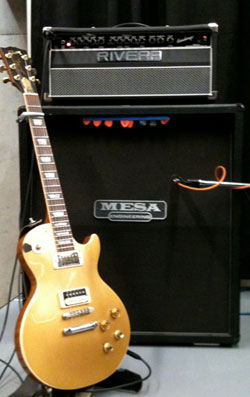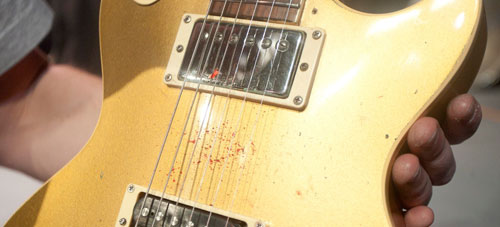Sanyo Pedal Juice Review, Pt 2
High Voltage!
by John Drenning
Okay, I’ll come clean. I have a Big Stupid Pedalboard.
It’s a Furman with eight power taps, four power outlets, casters and an extendable handle like the bags flight attendants use. It takes up about the same amount of floor space as a foosball table.
On it are two buffered Voodoo Labs switching units, a tuner, two compressors, an overdrive, two delays, a noise gate and a chorus. At least that’s what it has today. Tomorrow will be something different: A tremolo? Uni-vibe? Third compressor? Who knows.
Right next to it (since there’s no more room on the pedalboard itself!) there’s a wah and sometimes a volume pedal. Custom George L cables ensure sonic fidelity.
And…it has never left my basement.
Clearly something a little more spartan was in order for the AC/DC gig. If I went to see a band playing AC/DC, and the guitarist was using a delay or a chorus, I would give that guitarist a punch – and no court in the land would convict me.
So I settled on the basics:
> A tuner, since all those open-position chords sound like crap if your tuning is off, and mine usually is given that I compensate for my lack of chops by playing really, really hard.
> An ISP Decimator noise gate, since I’m sloppy (see previous sentence). And when you’re playing staccato start-and-stop stuff, they make you sound better than you really are.
> At the last minute, just to be saucy, I picked up a Line6 G50 wireless. This required a parallel DC chord for the receiver, but otherwise was a curve ball the Power Juice took in stride. I set the receiver by one of the monitors, right next to my tuner and gate, and I didn’t need to worry about finding AC at the front of the stage, or tripping over a 25-foot cord, or anything else that might impede my Rocking.
Amp/Cab
Amp-wise, I settled on my Rivera Fandango head through a Mesa/Boogie 4×12 Recto cab. The head is “only” 55w, though I swear it’s louder than my 100w Marshall. The Fandango has that EL34 bite, but it really cleans up nicely on the guitar’s volume knob. It also sports a fantastic reverb which didn’t seem overly non-Angus, and is as reliable as a tube amp can be. It also has a fantastic clean channel which I used, oh, never.
For leads, I used the amp’s footswitchable boost (one of the many thoughtful design elements of Rivera amps), a lot of pentatonic minor, and some well-timed grimaces.
The Recto cab is loaded with Vintage 30s and has less flab than Jillian Michaels.
Since I had to cover both rhythm and lead, and we were playing a big room, the guitar needed to be both huge and tight, which the Recto does as well as any cab I can afford. (When Russian Circles hires a second guitarist, I’ll get an Emperor cab. And a hernia.)
Guitar
I used the exact same guitar I played at my last gig, 18 years and 11 months before (but who’s counting): my mid-’70s Les Paul Deluxe goldtop – purchased for $400 in 1988 right before Guns & Roses broke and people started playing non-pointy guitars again, causing Les Paul prices to go through the roof.
I restrung it with .011s, which was a complete waste of six bucks, as I bled all over the strings. Evidently that’s not covered under string warranty.
The Juice Under Fire
With the Pedal Juice, setup was easy. I could get all my cables plugged into the pedals beforehand and not worry about draining power, since there’s an on/off button on top of the Pedal Juice. The button is recessed, and you have to hold it down for a few seconds to switch the unit off, so you won’t kill your pedals during a show (unless you inadvertently stand on it, and you gig in golf shoes – I do that sometimes).
The battery life LED also lets you know if the Pedal Juice is powered up, which is handy if you’re also the kind of guy who checks that his fly is up 30 times before hitting the stage.
I used the Pedal Juice for a bunch of practices before the show, and I think I may have recharged it once. Fifty hours is a lot of rocking. And believe me, it’s a long way to the top if you wanna rock ‘n’ roll.
During our two sets, the Pedal Juice did exactly what I wanted it to, which was to be completely invisible.
At the start of our set, I’d power it up, and we would commence to Rock out like it was going out of style (which sometimes I worry is actually happening – check out the top downloads on iTunes if you don’t believe me). hen at the end of the set, my Rocking complete, I’d just hold down the power button to shut the thing off.
No weird noises or funny stuff, my guitar sounded great, the wireless did its thing, and, oh my goodness, people actually got up and danced. Given how long it had been since I’d Rocked in a forum other than my basement, I didn’t want to have to worry about anything but Rocking properly. The Pedal Juice helped make this possible, without calling attention to itself in any other way. Rock on, Sanyo.
Bottom Line
Viewed within what I imagine Sanyo’s mission statement was, which was to provide a simple power solution for guitarists or bassists with non-behemoth pedalboards, I’d say the Pedal Juice worked like a champ. And at $150 street, it’s in the same price range as conventional power sources, but offers the convenience of liberating you from finding an AC outlet at the front of the stage.
I’m surprised it doesn’t come with a daisy-chain-style adapter, and the power cables themselves are pretty short. But if you’re running more than two pedals, just spend a couple bucks for a Hosa adapter and you’re in business.
My only other quibble might be that you can’t run the Pedal Juice off the wall-mount recharger while also using it to power your pedals. But it would take some pretty poor planning to have to do that in the first place, given the unit’s robust battery life, combined with the fact that the LED on top turns red when the remaining charge is at 30%.
To power a pedalboard that you actually intend to leave the house with, the Pedal Juice works great.
– End of part 2 of 2 –
Category: ISP, Les Paul, Line6, Mesa/Boogie, Reviews, Rivera, Sanyo, Stompboxes/FX
















I have one too a really like it. I use it for my beach set up – Para trabajo, I play at various hotels in Puerto Rico, mostly in San Juan. There’s always power for jobs, but now I can set where I want simple (and pick up and play later if I want to.)
Pedal Juice easily runs my board, pedals, etc., and even a small amp too. Lo quiero.
-J.E.
Full Disclosure: As you can tell by my screen name, I work for Sanyo…
Thank you for your excellent review! I especially love that you took Pedal Juice out for a spin in a live situation.
I only have one thought to share. For anyone that’s sitting on the fence because of price: The cost of 9Volts adds up.
Keep in mind:
– you can recharge Pedal Juice about 500 times
– each charge could provide up to 50 hours of quiet, continuous power
Quick math: If you hook up 5 analogue pedals to the Pedal Juice and play TEN 1 hour gigs each week, you wouldn’t have to buy 9Volts for maybe 10 years!
Oh, and one more tiny thing…
Pedal Juice is now widely available in BLACK.
I think it’s pretty gorgeous in the new color!
Best,
Deb From Sanyo